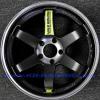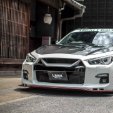Announcements
-
Similar Content
-
Latest Posts
-
Hi all, so I bought a very low kms 2019 Q60s in Nov 2022 and have been driving it stock for 17 months. The power from the VR30DETT has been a little scary as these cars did not come with a LSD. Although the ECU does well with compensating the lack of LSD by using automatic braking on different wheels when there is lost of traction etc, it does not really give me much confidence to push the car harder. Further to that, the car feels quite boaty especially around sharper corners or roundabouts - it would seem like the wheels are lifting on one side. These engines are also very prone to heat soak as the heat exchanger is tiny. I felt this during the heat wave in WA over summer even in normal driving. Gear shifting in the Q60 is also something that I hated - it's quite harsh at low speeds especially in traffic. I recently purchased a set of f&r sway bars, rear diff brace and a heat exchanger from Z1 in US. Here are my thoughts 1) Rear diff brace - no more wheel hop when accelerating quickly. wheel spin still present but manageable comparing to before. Gear shifts are now smoother, you can still tell its shifting etc but you dont feel the harshness. I would highly recommend this mod, and it should still be on sale at Z1 at the moment. 2) Sway bar - there are 2 settings for this F - 114%/165% increase in stiffness over stock and R - 138%/214% increase in stiffness over stock. Currently I am on the stiffer settings. The car feels very planted. Due to the weather over here I have not been able to test if i need to reduce the stiffness. So far it's much more comfortable to drive over stock as you dont feel like your car is lifting up and in fast turns you can control the car a lot better while turning left and right in quick succession. 3) HX - the Z1 HX has a much higher capacity and surface area (up to 200% or something). Again with the cooler weather it's a little hard to tell. I went with the Z1 HX due to the price, size and colour (black). You can't see the HX through the front bumper. There is a cheaper brand but it was smaller and the rest were more expensive which i didnt think was worth the extra since I won't track this car much at all. All 3 mods were easy to install, all plug and play. Note of caution, the front bar needed to come off for the HX to be installed.
-
A is the HICAS CU. As far as I know, there are no other modules located at A in a car with HICAS, so it is fair to presume that F is the variable power steer module for non-HICAS cars. Same location, give or take. Makes sense - the wiring loom for the HICAS cars has the speed signal, power, solenoid drive, etc wires all present there - so why move the module and have to upend the wiring loom? Having said the above though, it may be the case that F is further down in the rear guard - it's hard to tell. In which case it may be something else. Yes, it is the multi-pin plug next to the under dash fuse box. Top left corner. Can't miss it. Be very careful though - use insulated probes to poke around in there so you don't accidentally short 12v to ground or an ECU input etc etc.
-
They didn't. This is their comments; I'm not sure why they don't have the OEM specs.
-
Did the oil analysis include the acceptable range for Lead? Last one i has said 1ppm is the limit and the engine I was testing had 74, 80 and 33 (was the race car, tested from brand new run in engine). It may not help to tell you the engine didn't last long, but they never did back then
-





Recommended Posts
Create an account or sign in to comment
You need to be a member in order to leave a comment
Create an account
Sign up for a new account in our community. It's easy!
Register a new accountSign in
Already have an account? Sign in here.
Sign In Now